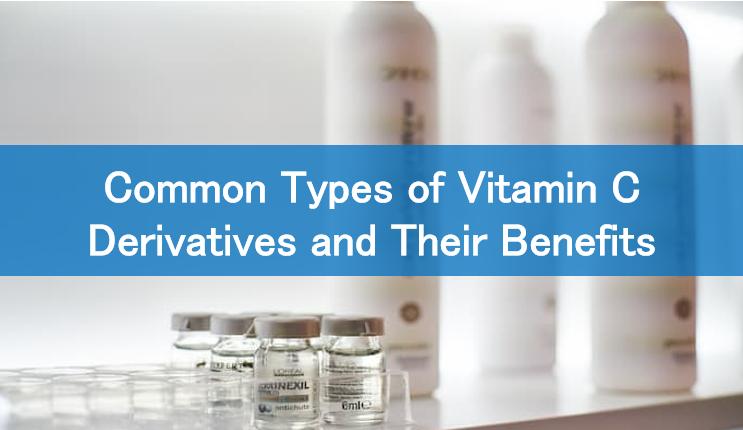
- HOME
- Cosmetic OEM Lab
What is vitamin C derivative
What are the differences between vitamin C and vitamin C derivative
Whare the benefits of vitamin C derivative
Vitamin C is one of skincare’s most studied and celebrated ingredients. Whether you’re targeting dullness, uneven skin tone, or early signs of aging, Vitamin C promises results. But if you’ve scanned a product label recently, you’ve likely come across more than just “Vitamin C” – you’ll find names like Sodium Ascorbyl Phosphate, Ascorbyl Glucoside, and 3-O-Ethyl Ascorbic Acid. These aren’t marketing fluff. They’re Vitamin C derivatives, and they serve a specific purpose.
In this guide, we’ll break down what Vitamin C derivatives are, how they differ from pure Vitamin C, the benefits of each, and how to combine them for maximum impact without irritating your skin.
Contents

Vitamin C isn’t just one ingredient—it’s a category. While pure Vitamin C (L-ascorbic acid) is the gold standard for efficacy, it’s notoriously unstable. This instability has led to the development of derivatives—chemically modified versions of Vitamin C designed to overcome its limitations.
Vitamin C derivatives are stabilized compounds that transform into active Vitamin C once absorbed by the skin. The main reason they exist? Stability and tolerance. Pure Vitamin C oxidizes quickly, especially when exposed to air, light, or heat. That means it can degrade before it even hits your skin—or worse, irritate it. Derivatives are engineered to remain shelf-stable longer, reduce irritation, and still deliver results—albeit sometimes more gradually.
The purpose of derivatives is twofold: they preserve the benefits of Vitamin C while making it easier to formulate with and more suitable for sensitive skin types. They’re often water- or oil-soluble, depending on the formulation, which gives formulators more flexibility.
L-ascorbic acid, or pure Vitamin C, is the most bioavailable form—meaning it’s ready to go as soon as it hits your skin. That also means it’s more potent but more reactive. It’s great for boosting collagen production, neutralizing free radicals, and fading pigmentation, but it can irritate sensitive or compromised skin and degrade quickly in the bottle.
Derivatives need to be converted by your skin into active Vitamin C. This extra step makes them less irritating and more stable but often slower to show results. However, that trade-off is worth it for many, especially if you’re new to Vitamin C or prone to sensitivity.

There’s no one-size-fits-all Vitamin C derivative. Each has its own unique structure, absorption rate, and benefits. Let’s look at the most popular ones and why they’re worth considering.
Ascorbyl Glucoside is a water-soluble derivative that combines Vitamin C with glucose. It’s known for being incredibly stable and gentle, making it ideal for sensitive skin or those just starting with Vitamin C.
MAP is another water-soluble option and one of the more hydrating derivatives. It’s often used in cream-based products due to its compatibility with moisturizers.
SAP is one of the most stable Vitamin C derivatives and shines in acne-fighting formulas. It has antimicrobial properties, which makes it an excellent choice for breakout-prone skin.
This oil-soluble derivative is often used in emulsions and creams, as it dissolves well in fats and oils. It’s less effective at collagen stimulation than some other forms, but it still delivers solid antioxidant benefits.
THD is a newer generation, oil-soluble derivative that’s gaining a lot of attention. It penetrates deeply into the skin and has a high conversion rate to active Vitamin C.
This semi-etherified derivative is considered one of the most promising because of its high stability and good skin penetration. It doesn’t require full conversion and can act directly as an antioxidant.

Vitamin C doesn’t have to do all the work on its own. When paired with the right companions, it performs even better. But it’s also important to know what not to mix with it.
Vitamin E and Vitamin C are a power couple in skincare. They work synergistically to boost each other’s antioxidant effects and protect against UV damage. Vitamin E also helps soothe and moisturize, which complements the brightening and firming benefits of Vitamin C.
Ferulic acid stabilizes Vitamin C and E, making all three more effective. This antioxidant trio is a favourite in high-end serums for fighting photoaging and free radical damage. It’s also known to increase the photoprotection of Vitamin C products.
Peptides promote collagen synthesis and skin repair. When paired with Vitamin C derivatives, the combination enhances firmness and elasticity over time. It’s a gentle yet effective duo for anti-aging routines.
Niacinamide and Vitamin C were once believed to cancel each other out, but that myth has long been debunked. They can actually coexist beautifully in the same routine, especially when used in stable forms. Niacinamide helps regulate oil, reduce redness, and refine pores—while Vitamin C brightens and protects.
While derivatives are more forgiving than pure L-ascorbic acid, some combinations still pose risks. Avoid mixing Vitamin C (in any form) with:
| Benzoyl peroxide |
|
| Strong exfoliating acids (AHAs/BHAs) |
|
| Copper peptides |
|
| Retinol |
|

Pure Vitamin C is powerful, but not always practical. Vitamin C derivatives offer a versatile, skin-friendly alternative with benefits that extend beyond brightening. Whether you’re easing into activities, dealing with sensitive skin, or just want something more stable and long-lasting, derivatives have earned their place in your routine.
From Ascorbyl Glucoside’s gentle brightening to THD’s deep skin penetration, the variety allows you to find the best fit for your skin’s needs. Pair your chosen derivative with complementary ingredients like Vitamin E or peptides, and steer clear of aggressive combos unless you’re a seasoned user.
Ultimately, the best Vitamin C product is the one you’ll actually use—and keep using. Choose what your skin can tolerate and what aligns with your goals. Because consistency, not hype, is what really transforms your skin.
For further information, please contact us.